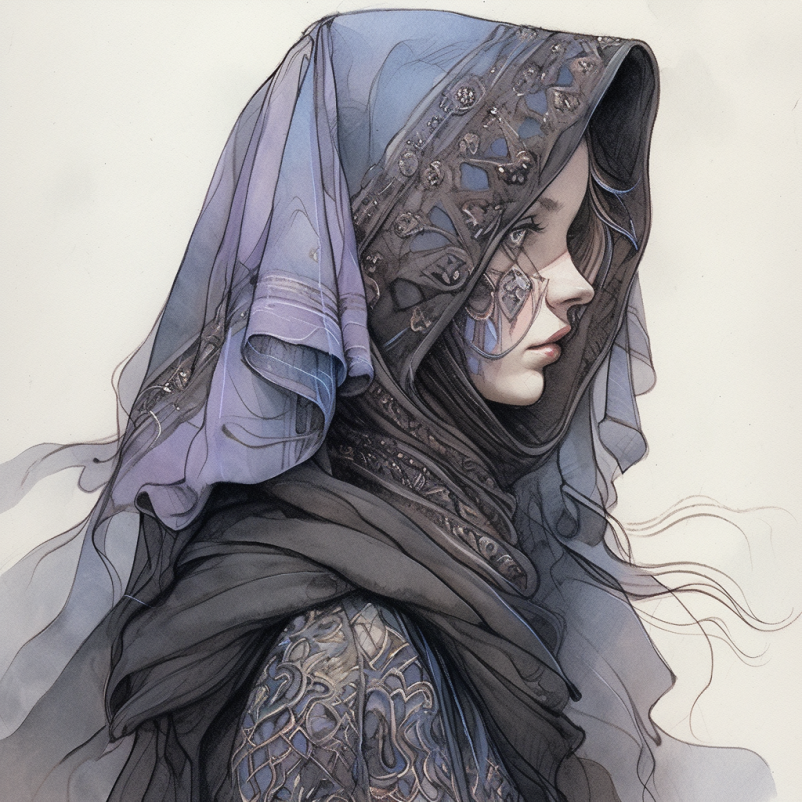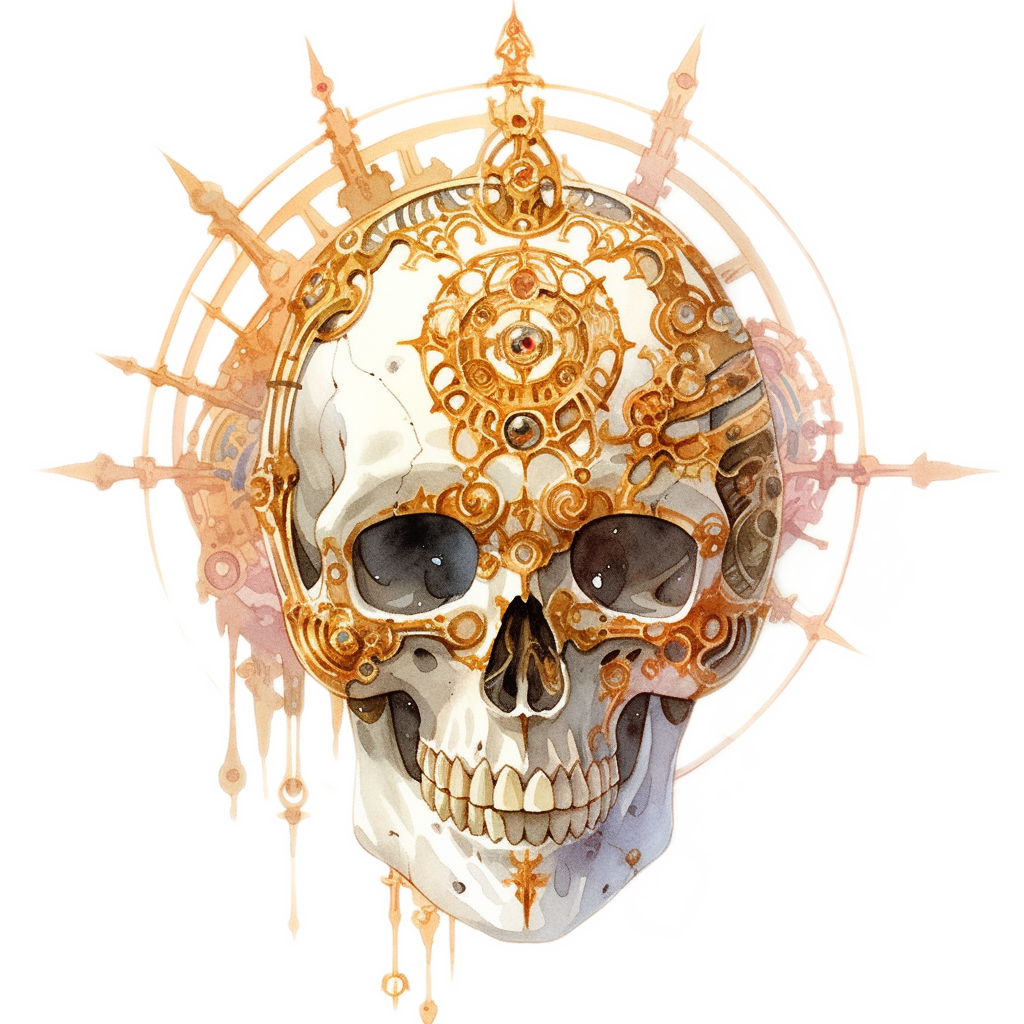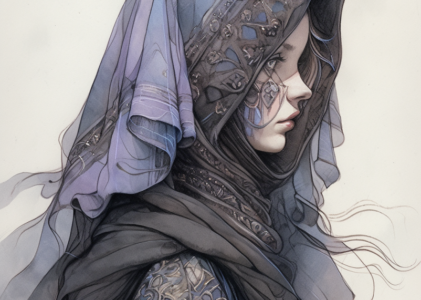(Prime human / former cleric of Myrkul [she/her] / Factor of the Athar / N)
It’s a rare blood who’ll believe something with all their hearts and minds for years, and then renounce everything they’ve ever stood for when their faith falters. If they can swallow the hypocrisy of their new stance, they’re often useful allies to their new cause. After all, such cutters know the strengths and weaknesses of their old order, and can contradict its teachings all the more effectively.
While the factions ain’t always keen to accept berks whose belief wavers with the wind (after all, sods like the Chameleons make a profession out of changing their mind), that’s not so for the Athar. These cutters delight in accepting priests whose well of belief’s dried up; those who’ve grown truly sceptical of the divinity of the powers. Remember berk: the Athar don’t dispute that the powers exist (even addle-coves can see that they do), but they do oppose the notion that the powers are Gods. So much better for the Lost then, when former priests strengthen their ranks with criticism of their ‘Creators’.
As a fallen cleric, Xashion’s far from alone. She hails from some little-know Prime world called Toril, where she worshipped Myrkul, a power who fancied himself as the Lord of Bones. Amongst his assumed portfolio were such delightful concepts as decay, wasting, old age and the dead. Back on her home world, Xashion (called the Withering Lord by her flock) conducted funerals, helped the sick to find their peace, and spread the morbid word that death was inescapable.
She enjoyed her work, in a cold-blooded sort of way. She liked the feeling of power that rushed through her body when she laid a mortal to rest, and the sideways glances of fear that most peasants afforded her. It’s said that to touch a priest of Myrkul is to invite death, so most wise bashers kept well clear of her.
She’d probably have stayed in the service of Old Lord Skull till her death if it hadn’t been for the “Time of Troubles”; a strange and apocalyptic event which blighted Toril some years back. It’s said that the OverPower of the Crystal Sphere (an enigmatic being named Ao) cast the gods from their realms in the planes, to wander the prime in avatar form. The chant goes that magic became unstable, and priests stopped receiving spells until the gods returned to their homes.
While Ao relented eventually and once again banished his powers from Toril, the Time of Troubles was not without its casualties. Several powers didn’t return to the Outer Planes, as they’d been slain by the hands of powerful mortals and other powers. Myrkul was one of these, they say. For his part in the theft of the artifacts known as the ‘Tablets of Fate’, Myrkul’s corpse was cast into the Astral Plane, along with the bodies of several other gods from the Pantheon of Toril.
The Lord of Bones had to be replaced, otherwise the spirits of dead mortals would have no place to go. A new power, Cyric (the Lord of Three Crowns), was chosen by Ao to replace Myrkul. The clergy of Myrkul, for the most part, were content to follow this new god of the dead. A few weren’t so easily convinced, however, and Xashion was one of these.
Xashion didn’t care for the philosophy of the Cyricists. See, the new power of the dead was also the power of murder. That meant that his priests’ duties now concerned not only burial, but killing too. Xashion wasn’t what you’d call ethically ‘good’, but she wasn’t the sort who’d be comfortable at a tanar’ri picnic, either. She lost faith in the new order, and in the action of a true fool or a true visionary, decided she’d see for herself what’d happened to her god.
Divinations led her to believe Myrkul was now on the Astral Plane, and since Cyric saw fit to grant spells of the Astral Sphere to his new devotees, Xashion took her chances. She cast the Astral Spell and stepped into the Great Silver Void. She explored the infinite wastes for an interminable time, somehow avoiding marauding githyanki and fearsome astral dreadnoughts. Eventually, she discovered a great land of decay, death and corruption, where final reckoning was tangible and the circle of life and death broken beyond repair. That place was Myrkul’s corpse.
“Primes? They’re quite insane!
– Montaigne, Athaeon
They wouldn’t know how to create a maggot,
yet they create ‘gods’ by the dozen!”
Xashion now describes it as an ironic moment, standing on the corpse of the dead god of death. Rather then being overcome with sadness, like she’d expected, Xashion began to laugh! Her life’s faith, everything she’d ever believed to be true, was dead beneath her feet. It’s been said many a time that it would’ve driven a lesser blood barmy, but Xashion was somehow fortified by her discovery. Unable to face returning to Toril where her future was dead, she decided to find herself a new purpose.
On her lonely sojourn in the Astral she’d met planewalkers who told her of Sigil; a wondrous city where belief was forged. Xashion had never lived without believing in something, so she resolved to find the city, and a new faith to follow.
Sigil confounded all of Xashion’s expectations. She found the array of factions confusing and frightening at first, then as she learned the chant, she found herself gravitating towards the Dustmen. Their concept of True Death gelled well with all she’d used to believe. She nearly joined them. It was a gnome, though, who showed her the light (by telling her the dark). Kesto Brighteyes, a book shop keeper and part-time lecturer for the Athar, caught her attention as she was walking to the Mortuary. The little fellow’s magic show reminded Xashion of home, where mages showed off their skills in the markets of Waterdeep. The prime and the planar got to talking, about belief and disbelief.
Xashion was surprised to hear that there were many bloods like her in the Cage, and that there was a faction for her: the Athar. Xashion realised that with the demise of her power, the spark of death within her had also died. She vowed not to cling to the past by joining the Dustmen, and instead signed up with the Lost.
She’s never looked back.

The Blasphemers
A keen blood usually gets her way in the Cage. Bashers like someone to lead ’em, and if their ideas are fresh and exotic, so much the better. Doubter Xashion took up the reins of the Athar real quick. She’s seen a lot, for a Clueless sod. Rarer still, she understands its significance. While she’d never been one for rhetoric before (priests of Myrkul don’t generally preach much), she found learning it easy. Her cynical attitude proved influential amongst the Lost, and pretty soon she had a band of loyal cutters right behind her. Popularity brought confidence, and that brought still stronger opinions.
Xashion’s now one of the most vocal bloods in the faction. She delights in confounding expectations, and rails against the establishment. She’s been the source of embarrassment for the Athar several times, and while Factol Terrance has tried to gag her more than once, her popularity’s made it hard for him to keep her quiet.
What’s the problem? The factions are supposed to stir up trouble, right? Well maybe, but Sigil’s a placed of many beliefs. It’s well known that most religions have major temples in the cage, and Xashion seems determined to insult as many priests as she can. The Athar’ve never been a popular faction with the temples, but Terrance has managed to avoid a Holy War this far. Xashion is rather less tactful than the factol. She’s a woman of many thoughts, and she’s not afraid to air them in public.
For example, her first controversy surfaced when she claimed that nothing exists. Her logic? The ‘gods’ reckon they created everything. Thing is, any Defier could tell a sod that gods don’t exist. So if these so-called gods are telling the truth, then nothing exists at all. And if things really do exist, then the gods must all be liars. It might’ve been a flawed argument, but it sure annoyed the temples for a few weeks, especially when Athar’d gatecrash their sermons to shriek ‘Nothing’s real!’ and daub their heretical slogans on church doors. It took the Harmonium and threats of persecution and prosecution to stop that little escapade.
The second tactic adopted by the Blasphemers (that’s what the cutters who follow Xashion’s whims call themselves) was to detract from the powers in subtler ways. The chant goes that the powers gain strength from worshippers’ devotion: their prayers, sacrifices and deep-seated belief. The Blasphemers, on Xashion’s prompting, decided that abusing the holy symbols, reversing prayers and mocking priests’ ceremonies would actually negate some of the powers’ power.
Groups of Blasphemers still gather to enact inverse services that the real religions use. (The Harmonium are rarely able to catch the Blasphemers at it, so this ploy’s still going strong). They pick powers indiscriminately; a good power one time, an evil one the next week, lawful, neutral and chaotic alike. They’re not biased against any particular power (though Brihaspati, the Vedic Lord of Prayer’s never far from the top of their list), trying rather to hit all religions equally.
Pantheons themselves are also great targets for the Blasphemers. As Xashion once said: “Power corrupts. Absolute power corrupts absolutely. Imagine then, how corrupt a whole bloody Pantheon must be!” By cancelling out the power of the powers, the Athar hope to show the ‘gods’ ain’t gods at all.
But the greatest coup for the Blasphemers came when Cyric himself was replaced, only a few years after he became Lord of the Dead. The chant goes that he created a magic book that’d make any who read it believe Cyric was the most powerful blood in the planes. Cyric made the mistake of reading the tome himself, and it drove him barmy. Since Ao wouldn’t let a barmy power look after the dead, another moral was promoted to fill Cyric’s shoes; a cutter named Kelemvor. When this chant reached the Athar there were howls of laughter. The powers couldn’t even keep themselves in order, let alone run a multiverse! For Xashion, it was the end of what little respect she’d still got for the powers. Twice in ten years the dead had been mocked by the games of their ‘divine’ minders.
Xashion’s response to the faction was that the conspiracy of the powers must be greater than they’d ever imagined. Far from being divine, the powers were alien creatures from another reality; a place where even they are weak in comparison with their peers. They crave domination above all, she says, so they’ve journeyed to this reality to exercise their narcissism over the mortals.
According to Xashion, the basic pillars of faith that hold up the churches are lies. She alleges that the powers don’t actually receive power from worship, but that they just pretend they do. Critics of her radical views (and there are many, even in the Athar) attack her stance, demanding she explain why the powers would construct an elaborate falsehood to the effect that they depended on mortals for their power.
It’s all a question of control, Xashion answers. How could a creature, even one as powerful as a power, control so many mortals? By fear? No, not even a power could muster the strength to cow billions of mortals into fearing him. By bribery? No, no power has the jink to garnish that many mortals. How then do powers keep their stranglehold on the planes?
It’s simple, if you think about it. The powers pretend that they need the worship of mortals. Then, not only do their egos get massaged by the pointless devotion of millions of souls, but the populace at large is peeled into thinking they’ve got a purpose: to believe. It’s all a bob; if they wanted, the mortals could tell the powers to go pike themselves, and they’d be free to do what they want. The powers are terrified of this; if they didn’t control the mortals, they could be overthrown.
That’s why powers invented the lie of the afterlife. Petitioners ain’t real, see. They’re not the spirits of the dead at all. They’re living sods who’ve been brainwashed by the powers into thinking they’re dead! She believes that the powers have used spells like contingency and powerful summoning magics to ensure that they have a steady currency of mortals arriving on their doorsteps. Like the planar races and the powers themselves, humans and the rest never die – they’re just made to believe they do! When a ‘mortal’ suffers enough damage that they believe they’re about to get put into the dead Book, the magical contingencies kick in, and transport them to a Power’s Realm. Here they’re made to believe they’re a petitioner, and focus their entire soul upon promoting the power. ‘Course, their memory’s wiped and they’re stripped of their identity; that’s why they don’t remember their past lives! That’s why they don’t have personalities! It all makes sense, berk! This only makes the disguise more complete. Petitioners are nothing more than the slaves of the powers! Worse than that, they’re food for the powers!
Proxies aren’t real either. They’re golem-like creations, all magical and false. Sure, a power might make one in the image of a living mortal once in a while, but it ain’t the mortal, it’s a peel! The real sod’s murdered by the power and hidden away all quiet while the rest of the multiverse carries on believing.
Xashion’s bold vision’s not one that the temples are comfortable with at all. Thing is, they just can’t prove it’s false; nobody knows for sure where the powers came from, and no-one understands the dark of death and afterlife. Answers from the powers aren’t likely to come, neither. It’s a good thing too. Xashion reckons the longer the powers stay silent, the more bloods begin to wonder just what it is they’re hiding.
Source: Jon Winter-Holt, mimir.net


A minor commentary, but didn’t Kelemvor replace Myrkul as the God of the Dead, whereas Cyric cheapshotted Bhaal for his mantle of Murder? I remember especially because Kelemvor kicked up a huge fuss about Myrkul’s Wall of the Faithless (which is thankfully a phenomenon only restricted to Toril’s sphere of petitioners, much like how Mystra’s magic ban after Karsus only applies to casters in Toril and outside of Toril access to level 10+ spells becomes available provided you’re not using ‘Torillian’ magecraft).
Hey there! I just fact checked this and I think we are both sort of right – Cyric initially took over from Myrkul and then the domain of god of the dead went to Kelemvor later on.
Yeah, I will admit also that I hadn’t reached the point where it mentioned Cyric losing office to Kelemvor. It’s been so long I guess I forgot that Cyric temporarily held the mantle of God of the Dead as well as Murder, so that’s my bad!
That being said I will note that the other thing I mentioned is a very interesting facet that rarely gets explored: Ed Greenwood himself confirmed during his Twitter Q&As that he often does that Mystra’s magic level ban only applies to Toril and in turn effectively established that each Prime world has its own unique style and method of spellcasting.
Basically that if you were a Torillian spellcaster who started romping the planes, you’d be using Torillian casting methods to use your magic, which means you’re still ultimately touching base with Mystra and her Weave, and are therefore subject to her rules and regulations. I guess you could treat it as a telecomm service or something to that extent. Different operators and systems that all do the same thing.
The key difference is that apparently it’s not simple to just change your magic casting style.. In essence to a Torillian spellcaster, learning to use the magic system of something like Krynn, for example, is apparently like trying to drive a car except you use the pedals to turn and the indicators to brake and the steering wheel to change gears. It can be done but you’re basically going to have to unlearn and relearn everything from scratch – but at least then you won’t be restrained by Mystra’s ban.
I find that this makes it especially interesting to look at things like Warlocks since it likely means they aren’t using the Weave, but instead they’re being taught strange and extraplanar spellcasting methods – for an extremely high tuition fee. Or at least, Warlocks should be doing it that way, if you ask me.
Speaking of Mystra’s ban and Warlocks, on the other hand, check out the Netherese Arcanist from the 2e books ‘Netheril: Empire of Magic’ (1996). It introduces the concept of Arcs as a kind of ‘mana points’ system for spellcasters (pretty sure it was also the precursor to what would become the foundation for the Sorcerer class in 3e/3.5) and I’ve essentially retooled it as a way of running Warlocks in 2nd Edition with some extra attachments due to the ‘otherworldly teacher’ angle.
But that’s just me tossing out some interesting tidbits and the like! Highly enjoyed the ‘anarcho-punk philosopher’ angle for Xashion, in regards to the actual content itself!